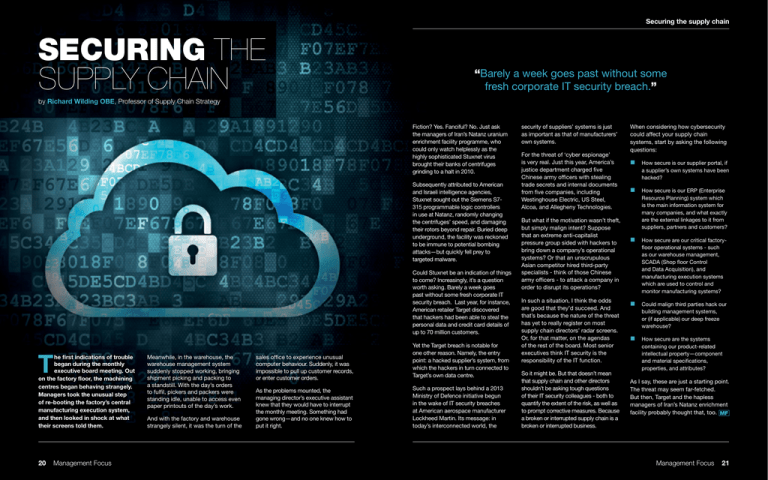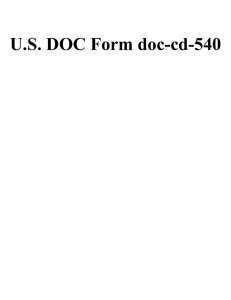SECURING SUPPLY CHAIN Securing the supply chain by
advertisement

Securing the supply chain SECURING THE SUPPLY CHAIN “Barely a week goes past without some fresh corporate IT security breach.” by Richard Wilding OBE, Professor of Supply Chain Strategy Fiction? Yes. Fanciful? No. Just ask the managers of Iran’s Natanz uranium enrichment facility programme, who could only watch helplessly as the highly sophisticated Stuxnet virus brought their banks of centrifuges grinding to a halt in 2010. Subsequently attributed to American and Israeli intelligence agencies, Stuxnet sought out the Siemens S7315 programmable logic controllers in use at Natanz, randomly changing the centrifuges’ speed, and damaging their rotors beyond repair. Buried deep underground, the facility was reckoned to be immune to potential bombing attacks—but quickly fell prey to targeted malware. Could Stuxnet be an indication of things to come? Increasingly, it’s a question worth asking. Barely a week goes past without some fresh corporate IT security breach. Last year, for instance, American retailer Target discovered that hackers had been able to steal the personal data and credit card details of up to 70 million customers. T he first indications of trouble began during the monthly executive board meeting. Out on the factory floor, the machining centres began behaving strangely. Managers took the unusual step of re-booting the factory’s central manufacturing execution system, and then looked in shock at what their screens told them. 20 Management Focus Meanwhile, in the warehouse, the warehouse management system suddenly stopped working, bringing shipment picking and packing to a standstill. With the day’s orders to fulfil, pickers and packers were standing idle, unable to access even paper printouts of the day’s work. And with the factory and warehouse strangely silent, it was the turn of the sales office to experience unusual computer behaviour. Suddenly, it was impossible to pull up customer records, or enter customer orders. Yet the Target breach is notable for one other reason. Namely, the entry point: a hacked supplier’s system, from which the hackers in turn connected to Target’s own data centre. As the problems mounted, the managing director’s executive assistant knew that they would have to interrupt the monthly meeting. Something had gone wrong—and no one knew how to put it right. Such a prospect lays behind a 2013 Ministry of Defence initiative begun in the wake of IT security breaches at American aerospace manufacturer Lockheed Martin. Its message: in today’s interconnected world, the security of suppliers’ systems is just as important as that of manufacturers’ own systems. For the threat of ‘cyber espionage’ is very real. Just this year, America’s justice department charged five Chinese army officers with stealing trade secrets and internal documents from five companies, including Westinghouse Electric, US Steel, Alcoa, and Allegheny Technologies. But what if the motivation wasn’t theft, but simply malign intent? Suppose that an extreme anti-capitalist pressure group sided with hackers to bring down a company’s operational systems? Or that an unscrupulous Asian competitor hired third-party specialists - think of those Chinese army officers - to attack a company in order to disrupt its operations? In such a situation, I think the odds are good that they’d succeed. And that’s because the nature of the threat has yet to really register on most supply chain directors’ radar screens. Or, for that matter, on the agendas of the rest of the board. Most senior executives think IT security is the responsibility of the IT function. So it might be. But that doesn’t mean that supply chain and other directors shouldn’t be asking tough questions of their IT security colleagues - both to quantify the extent of the risk, as well as to prompt corrective measures. Because a broken or interrupted supply chain is a broken or interrupted business. When considering how cybersecurity could affect your supply chain systems, start by asking the following questions: nn How secure is our supplier portal, if a supplier’s own systems have been hacked? nn How secure is our ERP (Enterprise Resource Planning) system which is the main information system for many companies, and what exactly are the external linkages to it from suppliers, partners and customers? nn How secure are our critical factoryfloor operational systems - such as our warehouse management, SCADA (Shop floor Control and Data Acquisition), and manufacturing execution systems which are used to control and monitor manufacturing systems? nn Could malign third parties hack our building management systems, or (if applicable) our deep freeze warehouse? nn How secure are the systems containing our product-related intellectual property—component and material specifications, properties, and attributes? As I say, these are just a starting point. The threat may seem far-fetched. But then, Target and the hapless managers of Iran’s Natanz enrichment facility probably thought that, too. MF MF Management Focus 21




